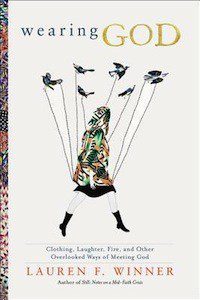
“For me religion is a vast, valuable museum… and yes, I know the treasures of it are not the same as going to the Louvre… although now that I think of it, there’s a good deal of overlapping, isn’t there?” –Elizabeth Hardwick, Paris Review interview
The task of describing God can be likened to many things. It might be like lassoing the moon, or like putting on an old sweater, or like nothing at all. Or it might be like describing what you saw one afternoon at the Met. “I go to the Metropolitan Museum of Art for an afternoon, and when I come out, I try to describe it to you, but all I am really describing is this blue Turkish bowl or that Flemish painting or possibly the sandwich I ate in the café at lunchtime,” Lauren F. Winner writes at the outset of her new book Wearing God: Clothing, Laughter, Fire, and Other Overlooked Ways of Meeting God. We don’t let the impossibility of the task at hand stop us from making attempts. Like untrained and ill-prepared mountain climbers trying to summit Everest, we continue up the side of the unknowable.
Winner, a former orthodox Jew whose conversion to Christianity she chronicled in her memoir Girl Meets God, parses centuries of people trying to make sense of God by drawing comparisons to concrete objects and ephemeral ideas. We talk about God in riddles and metaphors, in metonym and childhood constructs, or we don’t talk about God at all. Try as we might, God is easier depicted as a concept or in a simile than by direct approach, and we often hear the same words over and over again: King. Shepherd. Father.
But Winner deploys her lively spiritual imagination and bookworm sensibility to take us beyond cliché and into new territory. Or, really, old territory: As she opens the book with a chapter on God as clothing, we’re reminded that the conversation about imaging God goes back at least to Genesis, when God is depicted as clothier: “The LORD God made garments of skin for Adam and his wife and clothed them.” In this case, God was giving a gift to the mother and father of the human race; covering them up when their nakedness would have brought them shame. But it didn’t end there: Winner cites Galatians 3:28 (“There is neither Jew nor Greek, there is neither slave nor free, there is no male and female, for you are one in Christ Jesus”) to illustrate the point that Jesus is like a school uniform; a democratizing force that undoes social divisions rather than reinforcing them. Winner turns to a monograph about clothing in Emily Dickinson’s poems for clues about Jesus as a freeing garment, and reflects on her own experience of body shame as it relates to God’s good gift: “I so rarely even name this shame to myself; layers and layers of feminist politics and willed insistence that I love my body as it is keep me, most of the time, from a direct encounter with the shame.” If God is the one who clothes us, that says something about the goodness of our difficult, stubborn bodies.
There is a chapter on smell in which Winner deftly sketches the social connection between scent and virtue—the less you have of the former, the more you have of the latter—and asks us to consider what Jesus, in his often-homeless, wandering state would reek of. There is the story of a widow who wears her beloved’s Oxford shirts, and the suggestion that God may be like a mourner who is comforted in God’s grief by our scent. God and laughter is a separate subject of study, and here Winner makes an uncomfortable dive into the fact that most of God’s laughter in the Bible is a defiant laughter at injustice. There is a note from a woman’s prison—where Winner regularly teaches a class—on her decision not to include a chapter about the Biblical image of God as an abusive husband in Ezekiel 16 because it is hard to know what to make of this image from a place where 90% of women have been physically or sexually abused. Where we pray and where we read the Bible are issues of deep importance, and omitting this image is a sort of protest on Winner’s part.
The God of Christianity is often made to seem abstract and inaccessible, and images can only tell us so much about a thing before we run up against some sort of obstacle. But a composite of Scriptural images of God can create a helpful mosaic; where before we saw only two or three pieces, now we see something approaching a whole.

God as fire is not an uncommon metaphor, and it is a testament to Winner’s spiritual imagination that she translates this image with deeper examination. “[T]he fiery God is also a sleuth. Fire can tell the truth about an object’s composition… sodium produces a yellow flame, potassium a lilac flame, lithium a lovely crimson, and barium an apple green.” To say that God is fire, then, is not just to say God refines or God consumes or God destroys—although it is also to say those things—but that God knows what we are made of. This comparison of human hiddenness with elements like sodium and lithium does a lot of work for Winner, and brings to mind the Biblical idea of the fruit of the Spirit: love, joy, peace, forbearance, kindness, goodness, faithfulness, gentleness, and self-control. What color is joy, I wonder? What does kindness looks like when God reveals it? “What color flame do I produce when lit afire?” Winner asks. “Do I want to know?”
There aren’t many religious books in which women feature as prominently as they do in this one. It isn’t just that Winner is a woman and gives us a female lens through which to read; it’s that she gives us examples time and again of women who understood God in a way that illuminates our understanding of the divine: Catherine of Siena, a medieval Christian mystic; Nhat Chi Mai, a Buddhist nun who self-immolated in a demonstration for peace in Vietnam in 1967; the Raging Grannies, a group of older women who sing protest songs at Moral Monday demonstrations in Raleigh, North Carolina. Early on in the book we read “A Short Note on Gender and Language for God,” where Winner writes that “language arranges power.” Winner handles words like powerful things. I was once at a lecture Winner gave in which she referred to God as “she,” and someone in the audience, clearly upset, protested during the Q&A. The Bible calls God a mother hen and a laboring woman, Winner responded, not unkindly. If it’s good enough for the Bible, it’s good enough for us.
God is also imaged throughout the Bible as bread and wine, substances many middle-class American women have a complicated relationship to. “I know that every year, around February, I decide the most efficient way to lost the weight I gained in the deep-winter holiday months would be to forswear alcohol and to stop eating foods whose primary ingredient is flour… This is not so many steps from panicking about Communion bread.” One of the strengths of Winner’s writing is that she sees invitations to consider mystery where many of us, myself included, see only a wall. I, too, have looked at my stomach or hips and refused bread and butter when I was hungry, but I never stopped to consider that a piece of bread might be an invitation to be nourished by Christ; might, in fact, be more important than the size of my jeans.
Winner ends the book by considering the tradition of apophatic theology—the notion that we can better think about God by saying very little about God. “Maybe that is the best way to speak about God—to say and then unsay whatever we say.” How close can words come to capturing the infinite? But what else can we use, when words are all we have? Our language is capable, but the object of worship surpasses capability.




